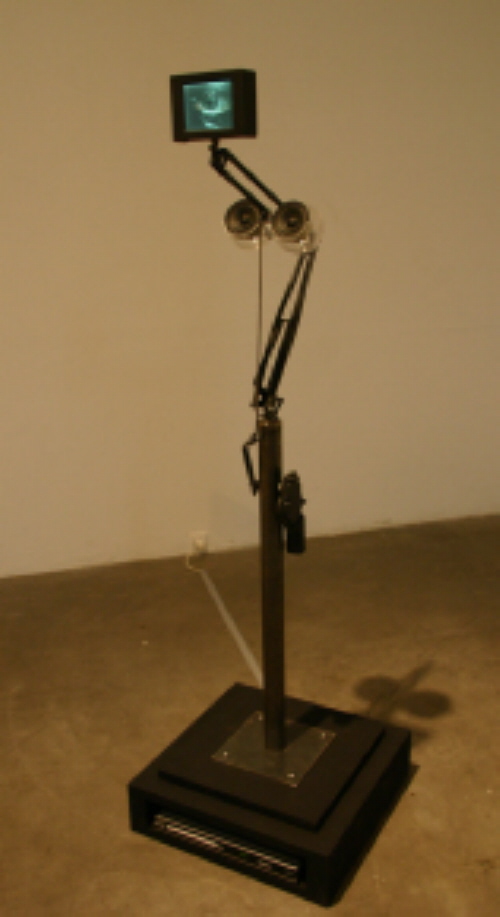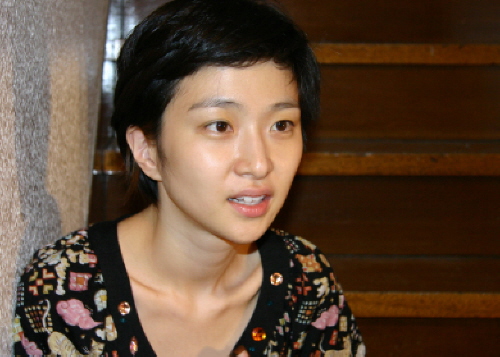While people were watching, the exhibition hall produced continuous sounds. In the exhibition space, various sounds filled the room. It was loud enough to horrify people at times, because the mixed audio data emitted special (or terrifying) sounds, and the atmosphere was quite dim. Several works operated suddenly and startled spectators, too. The new genre of art was a little bit difficult to understand but never boring.
‘Sound Effect Seoul 2007 (Seoul Sound Art Festival)’ treats sound performing art that uses ‘sound’ as a theme and a medium. However, its range is not limited, but rather open to the objectives that are able to be called ‘sorts of audios’. From such a view point, this festival began. Conference, workshops, performances and exhibitions are held with worldwide artists, curators and scholars for discussing the experimental and new art genre. The ‘International Symposium’ was held on September 8th at Yonsei University, and ‘Workshops’ were held on September 6th and 7th at Ind Cinema. The Chung-Ang Herald (CAH) visited the Total Museum to watch the ‘Exhibition Series’ among the many festival programs.
Irrespectively, it was more than that.
When we entered the room, which was filled with the creaky sounds and several machinelike exhibitions, CAH could hardly believe the picture on the wall. Its title was ‘Uncertainty Markers: Libellule / Dragonfly (2007), Jean-Pierre Gauthier’. Machinelike exhibitions were hung on the wall and they described something. It was not clear and had accurate shapes, because they moved randomly, but it looked splendid. Metallic lines, linked in two motors were operating on the wall, letting out and drawing in the sketching installation. Those irregular complicated and repeating movements seemed like they wanted to mesmerize spectators. Watching the process, people felt like they were being drawn into the wall. Then suddenly the exhibitions changed their way or felt just like insects. The works movement was similar to ‘living insects’, and it was even called a cockroach or a spider. Of course the creaky sound was never forgotten, either. It was from a microphone and machine using the microphone to draw lines on the wall. This audio sounded like insects, curiously enough. Spectators could find ‘nature’ from ‘artificiality’. It was artificial, but not artificial.
In the basement exhibition room, there were also other interesting works. The title was ‘Mobile Drum (2007), Robert Jacobsen’. This exhibition’s artist, Robert Jacobsen, only likes to create his own sculpture styles with ‘movement property’. Thus, the ‘Mobile Drum’ has it, too. His work is a kind of sound art, so indispensably it includes ‘sound’ in movement. The instrument was hanging from the ceiling and moved, drawing a circle, making the sound of a drum. With the sound, occasionally the cymbals next to the drum collided. It played sounds very randomly and automatically, so that it made have magical feeling.
Next to the drum, there was a special installation. It stood on the floor and has a LCD window. In the window, red full lips and an eye (only one side) came out repeatedly. The exhibition produced a ‘voice’ that was low, thick and terrifying. The voice was not that beautiful but very impressive.
Korean artist Kim Young-sup’s work had a force, too. On the long table, tray-shaped sculptures were placed in two rows. On the wooden floor, several sentences were written just as a warning. ‘You should not blame the floor even if you fall down into the floor.’ ‘It is a wrong to think that the floor will support you forever.’ The sounds did not change, but there were different kinds of castanets’ sounds that were heard endlessly. The space, background and light were dark and shut. It was quite horrible. Where on earth was this sound from?
The exhibition of the sound art was ‘a fresh shock’. Certainly, it was not easy or light. However, the material that was so close to our life was used in the art in a breathtaking way. Leaving the exhibition hall, a sentence came across. “Whatever you imagine, you will see more than that.”
WHAT IS ‘SOUND ART’?
Sound art is a modern visual art that introduces sound. Generally, it is made from carvings and modeling method called ‘sound sculpture’, too. It began a very long time ago as did synthetic art. A gallery, exhibition hall and performance place are the main stages of sound art. It is displayed on the ground and presented as a form of cassette tape or performance.
Interview
Sound is different from music.
CAH met an artist who joined the exhibition. Christof Migone, who is an active artist in Canada, is doing various exhibitions from sound and video to performance and installation. He experiments mainly with language, voice, body, intimacy, complexity and patience. He is now a professor at Concordia University, Canada.
CAH: Please explain about your artwork.
Christof Migone: The work I did here is called ‘Hit Parade’. I had ten people on the streets, walking the streets, lying faced down, and hitting the ground with a microphone, one thousand times. Then I made a hole in the wall with the destroyed microphones, etc. The diverse material used in my works, but I work a lot with microphones. I work with sound, but not only with sound. I am more known as a sound artist, but I am more excited when people call me ‘conceptual artist’.
CAH: The sound art genre is not familiar to people. Can you explain this is simple terms?
Christof Migone: I usually say, I am a sound artist. When l think about ‘sound’, that is not music. So, right now we are hearing birds, conversations, footsteps and those are all sound of art. Marcel Duchamp, who is a very famous French artist, took a urinal from a bathroom and he put it in the museum. And that act of finding an object in bathroom, putting in the museum, calling it art and signing it, is a kind of art. Anything, could be utilized in art.
CAH: What kind of work do you want to do?
Christof Migone: I often work exploring the potential sonic properties of the body. Maybe, there are other things that the body can make that have a sound. I’ve found spots where create the sound of bones cracking, with the eyes flicking, etc. So, I want to express all kinds of sound, which is very simple such as squish.
Is it difficult? These experimental arts are close to our life.
CAH: Sound art is sensitive, but isn’t it just abstruse?
Yang Jiyoon (Yang): Basically, it uses ‘sound’. In case of sight, we can easily deny seeing by closing our eyes, but we can not block auditory senses. Sound art is focusing on that point; ‘Sound’ is always with us. It is not difficult. However, many people say that modern art is abstruse, and sound art is a kind of modern art, too. It is more important to understand that these experimental arts are very close to our life.
CAH: What is a special point of ‘Seoul Sound Art Festival’?
Yang: America and Europe started ‘Sound art’ from the middle 1990s. Japan has a long history, too. However, in Korea, sound artists have only started working recently from the 2000s. To show this recent interest in Korea regarding sound and worldwide sound artists’ work, this festival was expected. At first, it was a small event, but it grew bigger.
CAH: Is there any memorable work?
Yang: Well, I’d like to recommend Jean-Pierre Gauthier’s Uncertainty Markers. He always made some strange machinelike works with daily things. His works have not only an interest for sight, but also a special sound. Of course, there are more interesting art works in the other three galleries.

